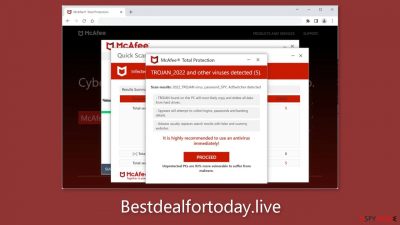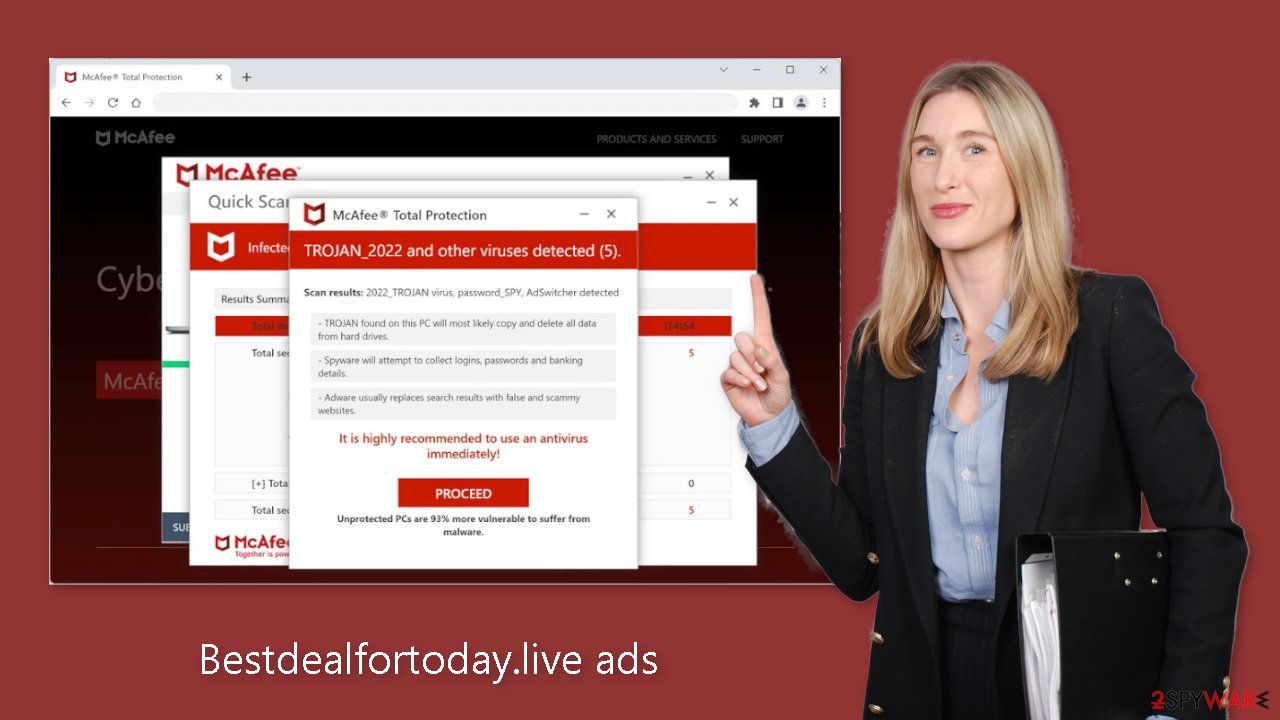Bestdealfortoday.live ads (scam) - Free Guide
Bestdealfortoday.live ads Removal Guide
What is Bestdealfortoday.live ads?
Bestdealfortoday.live is a dubious site that is designed to look like a McAfee security alert

Bestdealfortoday.live is a fraudulent website created by crooks for financial gain. The website is designed to resemble a security alert from McAfee, a well-known antivirus suite. McAfee, on the other hand, has nothing to do with this fraudulent campaign. It was completely made up by people who want to fool individuals into believing their computer is infected with multiple viruses.
The site may also begin annoying users with pop-up ads. Fraudsters may be using rogue advertising networks,[1] causing people to click on dangerous websites. Scam websites may attempt to dupe users into providing personal information, downloading PUPs (potentially unwanted programs),[2] and even malware.
| NAME | Bestdealfortoday.live |
| TYPE | Push notification spam, adware |
| SYMPTOMS | Multiple pop-ups appear displaying messages that suggest the system is infected |
| DISTRIBUTION | Shady websites, deceptive ads, freeware installations |
| DANGERS | People can get spammed with pop-ups that say their system is infected and install PUPs or malware unknowingly |
| ELIMINATION | To disable the pop-ups go to your browser settings; scanning your system with professional security tools is recommended |
| FURTHER STEPS | Use a maintenance tool FortectIntego to clear your browsers and fix any remaining damage |
Distribution methods
Bestdealfortoday.live pages almost never appear in search results. They usually hide on other shady, unregulated sites. Illegal streaming sites, for example, are riddled with deceptive ads, sneaky redirects, and fake “Download” and “Play” buttons.[3] That is why you should only visit websites you know and trust.
Use legitimate streaming services such as Netflix or Hulu. They have a low monthly subscription fee and allow users to watch as much content as they want safely. Do not click on random links and advertisements. Even if the advertisements appear to promote legitimate products or services, it is best to go directly to the source.
Another possibility is that the suspicious page appeared without any user input. This can occur if you are infected with adware. It is ad-supported software that can result in an increase in commercial content such as pop-ups, banners, and redirects.

How to disable pop-ups?
Push notifications displayed by shady sites can lead to scams. To stop them, you have to block the site permissions that allow it to show you push notifications. You can do that by following our step-by-step guide:
Google Chrome (desktop):
- Open Google Chrome browser and go to Menu > Settings.
- Scroll down and click on Advanced.
- Locate the Privacy and security section and pick Site Settings > Notifications.
![Stop notifications on Chrome PC 1 Stop notifications on Chrome PC 1]()
- Look at the Allow section and look for a suspicious URL.
- Click the three vertical dots next to it and pick Block. This should remove unwanted notifications from Google Chrome.
![Stop notifications on Chrome PC 2 Stop notifications on Chrome PC 2]()
Google Chrome (Android):
- Open Google Chrome and tap on Settings (three vertical dots).
- Select Notifications.
- Scroll down to Sites section.
- Locate the unwanted URL and toggle the button to the left (Off setting).
![Stop notifications on Chrome Android Stop notifications on Chrome Android]()
Mozilla Firefox:
- Open Mozilla Firefox and go to Menu > Options.
- Click on Privacy & Security section.
- Under Permissions, you should be able to see Notifications. Click Settings button next to it.
![Stop notifications on Mozilla Firefox 1 Stop notifications on Mozilla Firefox 1]()
- In the Settings – Notification Permissions window, click on the drop-down menu by the URL in question.
- Select Block and then click on Save Changes. This should remove unwanted notifications from Mozilla Firefox.
![Stop notifications on Mozilla Firefox 2 Stop notifications on Mozilla Firefox 2]()
Safari:
- Click on Safari > Preferences…
- Go to Websites tab and, under General, select Notifications.
- Select the web address in question, click the drop-down menu and select Deny.
![Stop notifications on Safari Stop notifications on Safari]()
MS Edge:
- Open Microsoft Edge, and click the Settings and more button (three horizontal dots) at the top-right of the window.
- Select Settings and then go to Advanced.
- Under Website permissions, pick Manage permissions and select the URL in question.
- Toggle the switch to the left to turn notifications off on Microsoft Edge.
![Stop notifications on Edge 2 Stop notifications on Edge 2]()
MS Edge (Chromium):
- Open Microsoft Edge, and go to Settings.
- Select Site permissions.
- Go to Notifications on the right.
- Under Allow, you will find the unwanted entry.
- Click on More actions and select Block.
![Stop notifications on Edge Chromium Stop notifications on Edge Chromium]()
Clean your browsers
After removal, we recommend using the FortectIntego repair tool to maintain your browsers. Cookies are used by almost every website you visit to track your browsing activity, such as the pages you visit, links you click on, and purchases you make.
If you're seeing pop-ups from suspicious sources, it's most likely because you were browsing web pages you shouldn't have been and clicked on dangerous links. Your browsing data may be exposed or sold to ad networks, who will use it to target you with even more ads.
Use anti-malware tools to detect adware
If you disabled push notifications but still experience unwanted symptoms such as unexpected redirects and an increase in commercial content such as pop-ups and banners, you should run an adware scan on your system. It is mostly distributed through freeware distribution sites. They include additional programs in the installers but do not make this clear on their websites.
We recommend using trusted professional security tools SpyHunter 5Combo Cleaner or Malwarebytes that can automate this process. Most suspicious apps should be detected and removed successfully. Of course, you can remove a PUP manually, but because it is unknown which specific app is causing the annoying behavior, removing it can be difficult if you lack experience – you risk deleting the wrong applications.
Manual uninstallation may also leave some traces of the program behind, which may result in the infection reappearing. If you still do not want to use security tools and know which program is at fault, follow our instructions to uninstall it:
Windows 10/8:
- Enter Control Panel into Windows search box and hit Enter or click on the search result.
- Under Programs, select Uninstall a program.
![Uninstall from Windows 1 Uninstall from Windows 1]()
- From the list, find the entry of the suspicious program.
- Right-click on the application and select Uninstall.
- If User Account Control shows up, click Yes.
- Wait till uninstallation process is complete and click OK.
![Uninstall from Windows 2 Uninstall from Windows 2]()
Windows 7/XP:
- Click on Windows Start > Control Panel located on the right pane (if you are Windows XP user, click on Add/Remove Programs).
- In Control Panel, select Programs > Uninstall a program.
![Uninstall from Windows 7/XP Uninstall from Windows 7/XP]()
- Pick the unwanted application by clicking on it once.
- At the top, click Uninstall/Change.
- In the confirmation prompt, pick Yes.
- Click OK once the removal process is finished.
Mac:
- From the menu bar, select Go > Applications.
- In the Applications folder, look for all related entries.
- Click on the app and drag it to Trash (or right-click and pick Move to Trash)
![Uninstall from Mac 1 Uninstall from Mac 1]()
To fully remove an unwanted app, you need to access Application Support, LaunchAgents, and LaunchDaemons folders and delete relevant files:
- Select Go > Go to Folder.
- Enter /Library/Application Support and click Go or press Enter.
- In the Application Support folder, look for any dubious entries and then delete them.
- Now enter /Library/LaunchAgents and /Library/LaunchDaemons folders the same way and terminate all the related .plist files.
![Uninstall from Mac 2 Uninstall from Mac 2]()
How to prevent from getting adware
Stream videos without limitations, no matter where you are
There are multiple parties that could find out almost anything about you by checking your online activity. While this is highly unlikely, advertisers and tech companies are constantly tracking you online. The first step to privacy should be a secure browser that focuses on tracker reduction to a minimum.
Even if you employ a secure browser, you will not be able to access websites that are restricted due to local government laws or other reasons. In other words, you may not be able to stream Disney+ or US-based Netflix in some countries. To bypass these restrictions, you can employ a powerful Private Internet Access VPN, which provides dedicated servers for torrenting and streaming, not slowing you down in the process.
Data backups are important – recover your lost files
Ransomware is one of the biggest threats to personal data. Once it is executed on a machine, it launches a sophisticated encryption algorithm that locks all your files, although it does not destroy them. The most common misconception is that anti-malware software can return files to their previous states. This is not true, however, and data remains locked after the malicious payload is deleted.
While regular data backups are the only secure method to recover your files after a ransomware attack, tools such as Data Recovery Pro can also be effective and restore at least some of your lost data.
- ^ Zeljka Zorz. How does a rogue ad network function?. Helpnetsecurity. Information Security Blog.
- ^ Potentially unwanted program. Wikipedia, the free encyclopedia.
- ^ Andy Maxwell. Google Targets Fake ‘Download’ and ‘Play’ Buttons. Torrentfreak. Filesharing News.













